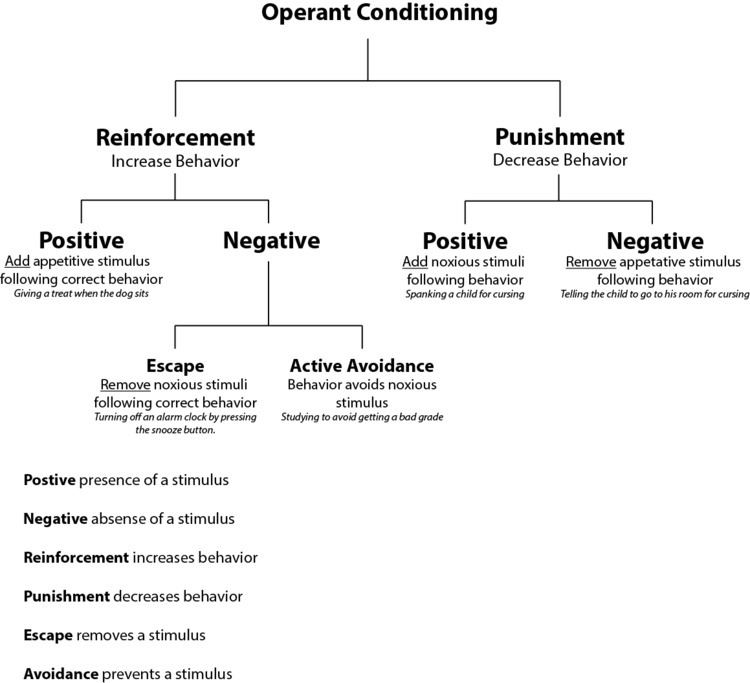 | ||
In operant conditioning, punishment is any change in a human or animal's surroundings that occurs after a given behavior or response which reduces the likelihood of that behavior occurring again in the future. As with reinforcement, it is the behavior, not the animal, that is punished. Whether a change is or is not punishing is determined by its effect on the rate that the behavior occurs, not by any "hostile" or aversive features of the change. For example, a painful stimulus which would act as a punisher for most people may actually reinforce some behaviors of masochistic individuals.
Contents
Types
There are two types of punishment in operant conditioning:
Punishment is not a mirror effect of reinforcement. In experiments with laboratory animals and studies with children, punishment decreases the likelihood of a previously reinforced response only temporarily, and it can produce other "emotional" behavior (wing-flapping in pigeons, for example) and physiological changes (increased heart rate, for example) that have no clear equivalents in reinforcement.
Punishment is considered by some behavioral psychologists to be a "primary process" – a completely independent phenomenon of learning, distinct from reinforcement. Others see it as a category of negative reinforcement, creating a situation in which any punishment-avoiding behavior (even standing still) is reinforced.
Positive
Positive punishment occurs when a response produces a stimulus and that response decreases in probability in the future in similar circumstances.
Negative
Negative punishment occurs when a response produces the removal of a stimulus and that response decreases in probability in the future in similar circumstances.
Reinforcement versus punishment
Simply put, reinforcers serve to increase behaviors whereas punishers serve to decrease behaviors; thus, positive reinforcers are stimuli that the subject will work to attain, and negative reinforcers are stimuli that the subject will work to be rid of or to end. The table below illustrates the adding and subtracting of stimuli (pleasant or aversive) in relation to reinforcement vs. punishment.
Aversives
Aversive stimulus, punisher, and punishing stimulus are somewhat synonymous. Punishment may be used for (a) an aversive stimulus or (b) the occurrence of any punishing change or (c) the part of an experiment in which a particular response is punished. However, some things considered aversive (such as spanking) can become reinforcing. In addition, some things that are aversive may not be punishing if accompanying changes are reinforcing. A classic example would be mis-behavior that is 'punished' by a teacher but actually increases over time due to the reinforcing effects of attention on the student.
Primary versus secondary
Pain, loud noises, foul tastes, bright lights, and exclusion are all things that would pass the "caveman test" as an aversive stimulus, and are therefore primary punishers. The sound of someone booing, the wrong-answer buzzer on a game show, and a ticket on your car windshield are all things you have learned to think about as negative, and are considered secondary punishers.
Importance of contingency and contiguity
One variable affecting punishment is contingency, which is defined as the dependency of events. A behavior may be dependent on a stimulus or dependent on a response. The purpose of punishment is to reduce a behavior, and the degree to which punishment is effective in reducing a targeted behavior is dependent on the relationship between the behavior and a punishment. For example, if a rat receives an aversive stimulus, such as a shock each time it presses a lever, then it is clear that contingency occurs between lever pressing and shock. In this case, the punisher (shock) is contingent upon the appearance of the behavior (lever pressing). Punishment is most effective when contingency is present between a behavior and a punisher. A second variable affecting punishment is contiguity, which is the closeness of events in time and/or space. Contiguity is important to reducing behavior because the longer the time interval between an unwanted behavior and a punishing effect, the less effective the punishment will be. One major problem with a time delay between a behavior and a punishment is that other behaviors may present during that time delay. The subject may then associate the punishment given with the unintended behaviors, and thus suppressing those behaviors instead of the targeted behavior. Therefore, immediate punishment is more effective in reducing a targeted behavior than a delayed punishment would be.
Applied behavior analysis
Punishment is sometimes used for treatment programs in applied behavior analysis in the most extreme cases, to reduce dangerous behaviors such as head banging or biting exhibited most commonly by children or people with special needs or disabilities. Punishment is considered one of the ethical challenges to autism treatment and is one of the major reasons for discussion of professionalizing behavior analysis. Professionalizing behavior analysis through licensure would create a board to ensure that consumers or families had a place to air disputes. (see Professional practice of behavior analysis)
Psychological manipulation
Braiker identified the following ways that manipulators control their victims:
Traumatic bonding
Traumatic bonding occurs as the result of ongoing cycles of abuse in which the intermittent reinforcement of reward and punishment creates powerful emotional bonds that are resistant to change.
